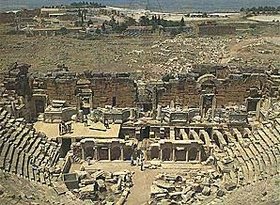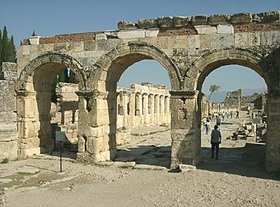Hierapolis
|
|
Hierapolis (Arabic Manbij or Mumbij) is an ancient city located in Turkey, in a fertile district about 16 miles southwest of the confluence of the Sajur and Euphrates. There is abundant water supply from large springs.
In 1879, after the Russo-Turkish War, a colony of Circassians from Vidin (Widdin) was planted in the ruins, and the result has been the constant discovery of antiquities, which find their way into the bazaars of Aleppo and Aintab. The place first appears in Greek as Bambyce, but Pliny (v. 23) tells us its Syrian name was Mabog. It was doubtless an ancient Commagenian sanctuary; but history records it first under the Seleucids, who made it the chief station on their main road between Antioch and Seleucia-on-Tigris; and as a centre of the worship of the Syrian Nature Goddess, Atargatis, it became known to the Greeks as the city of the sanctuary Ιεροπολις, and finally as the Holy City Ιεραπολις.
This worship was immortalized in the tract De Dea Syria (usually attributed to Lucian, a native of Commagene) has immortalized this worship, wherein are described the orgiastic luxury of the shrine and the tank of sacred fish, of which Aelian also relates marvels. According to the De Dea Syria, the worship was of a phallic character, votaries offering little male figures of wood and bronze. There were also huge phalli set up like obelisks before the temple, which were climbed once a year with certain ceremonies, and decorated.
For the rest the temple was of Ionic character with golden plated doors and roof, and much gilt decoration. Inside was a holy chamber into which only priests were allowed to enter. Here were statues of a goddess and a god in gold, but the first seems to have been the more richly decorated with gems and other ornaments. Between them stood a gilt xoanon, which seems to have been carried outside in sacred processions. Other rich furniture is described, and a mode of divination by movements of a xoanon of Apollo. A great bronze altar stood in front, set about with statues, and in the forecourt lived numerous sacred animals and birds (but not swine) used for sacrifice.
Some three hundred priests served the shrine and there were numerous minor ministrants. The lake was the centre of sacred festivities and it was customary for votaries to swim out and decorate an altar standing in the middle of the water. Self-mutilation and other orgies went on in the temple precinct, and there was an elaborate ritual on entering the city and first visiting the shrine under the conduct of local guides, which reminds one of the Mecca Pilgrimage.
The temple was sacked by Crassus on his way to meet the Parthians (53 BC); but in the 3rd century of the empire the city was the capital of the Euphratensian province and one of the great cities of Syria. Procopius called it the greatest in that part of the world. It was, however, ruinous when Julian collected his troops there ere marching to his defeat and death in Mesopotamia, and Khosrau I held it to ransom after Justinian had failed to put it in a state of defence. Harun restored it at the end of the 8th century and it became a bone of contention between Byzantines, Arabs and Turks. The crusaders captured it from the Seljuks in the 12th century, but Saladin retook it (1175), and later it became the headquarters of Hulagu and his Mongols, who completed its ruin.
The remains are extensive, but almost wholly of late date, as is to be expected in the case of a city which survived into Moslem times. The walls are Arab, and no ruins of the great temple survive. The most noteworthy relic of antiquity is the sacred lake, on two sides of which can still be seen stepped quays and water-stairs. The first modern account of the site is in a short narrative appended by H Maundrell to his Journey from Aleppo to Jerusalem Hewasat Mumbij in 1699.
The coinage of the city begins in the 4th century BC with an Aramaic series, showing the goddess, either as a bust with mural crown or as riding on a lion. She continues to supply the chief type even during imperial times, being generally shown seated with the tympanum in her hand. Other coins substitute the legend O~.s ~vpias ‘I€poiro?urii’v, within a wreath. It is interesting to note that from Bambyce (near which much silk was produced) were derived the bombycina vestis of the Romans and, through the crusaders, the bombazine of modern commerce.
It is one of the World Heritage Sites in Turkey together with Pamukkale.
References
- FR Chesney, Euphrates Expedition (1850)
- WF Ainsworth, Personal Narrative of the Euphrates Expedition (1888)
- E Sachau Reise in Syrien, &c. (1883)
- DG Hogarth in Journal of Hellenic Studies (1909)de:Hierapolis


